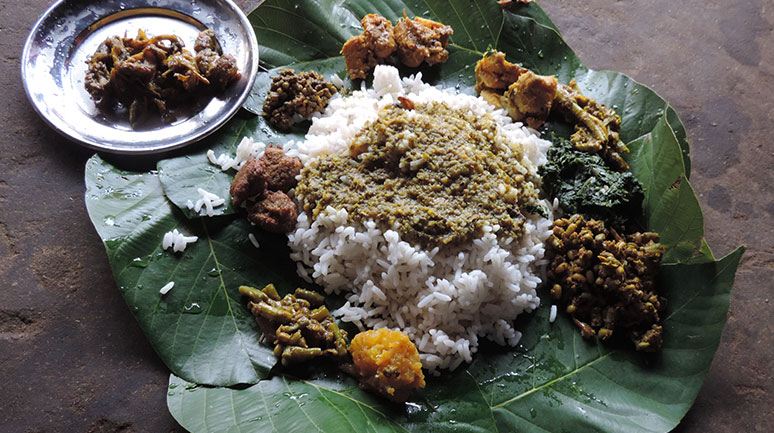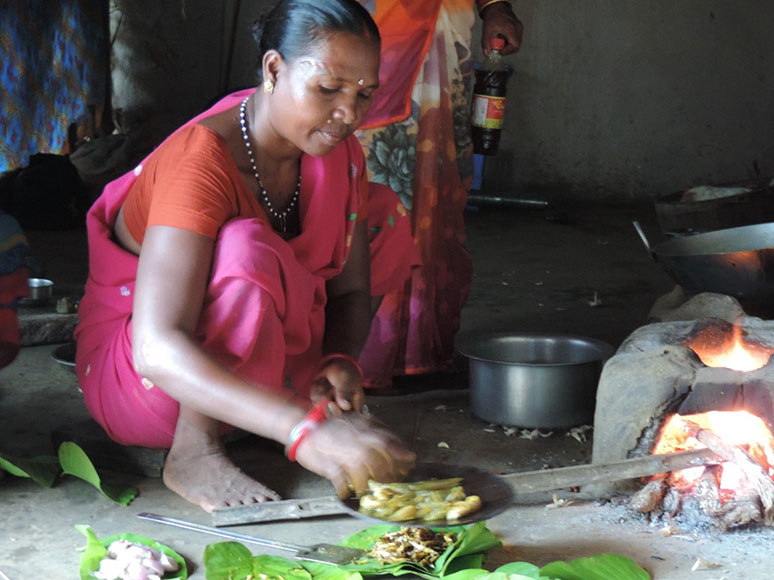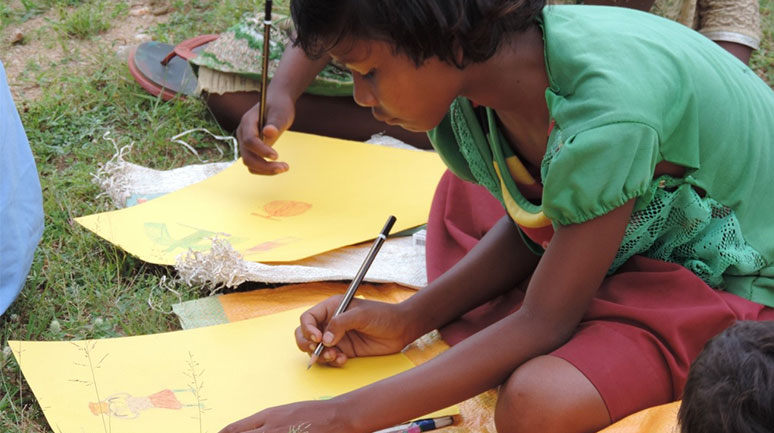Towards an Effective Language of Facilitation


A Santhal woman cooking a traditional local fish recipe; the fish was caught from the stream near the village
Imposing developmental solutions in a language foreign to the villagers is a pitfall that Development Practitioners must avoid. True transformation happens when practitioners communicate their knowledge and wisdom in the local language and with deep understanding of the traditional culture and practices of the tribals they are engaged with
Introduction
I am an Engineer by training and I chose to work as a Development Practitioner in the rural hinterlands of India. I was placed in Bihar (Chakai block, Jamui district), which is predominantly a tribal area. Although, initially, I took time to adjust to the place, what motivated me to continue my stay there, were the visible changes in the lives of the community I was working with. I realised that I could play a significant role here. I went through many training programmes, including some on rural livelihoods, gender and natural resource management. Well-equipped with enhanced knowledge and skills, the time came for me to share my understanding with the community. The important thing was how do I transfer the knowledge I have gained, to the community. One of the primary skills required here is ‘facilitation’. How can I best ‘facilitate’ a complex community, with its social divisions and political dynamics, so as to implement the project I have been assigned?
This writing is an expression of my reflections on implementing several projects in the Chakai region. It has emerged from the contradictions I faced when the projects and our community facilitation were not always aligned. This action research work will reflect some changes in the current practices and also how reflection-in-action has served to strengthen my basic facilitation skills. Let me begin by sharing some experiences that I encountered during my interactions with the community. These experiences have led me to reflect on and re-orient some of my actions. It has also challenged two of my main skills of facilitation: empathy and building on existing culture and knowledge.
Case 1: At a concept seeding meeting in Jogiraydih village of Dulampur panchayat, which is a Santhal village. I noticed that the women were not participating in the discussion. Although I tried my best to encourage the women to join the discussion, most of them remained silent. I became very frustrated. At that time, a local trader of kendu leaves joined us and I saw the women interacting with him very easily. They were all conversing in Santali. This time, I was the one who was silent. I realised that the language barrier was a very big block between the community and me. It ruled out the possibility of my listening to them.
Case 2: I conducted a training on the System of Rice Intensification (SRI) method of paddy cultivation in Ektara village, Nouadih panchayat. The training involved demonstrating different steps in SRI cultivation. Before moving on to a new step, I would ask the participants to recall the previous one. And no one would answer. I repeated the steps many times but again no answer. I felt very irritated. My co-trainer said that the community needs more time to understand because they are tribals. He assured me that once the neighbouring village takes up the activity, the villagers here will also start cultivation. However, a while back, I had seen some of the villagers transplanting finger millet seedlings using a method similar to the SRI method. I was confused. ‘Do they know the method or do they need more time to understand? Also, what is the reason behind that?’
Case 3: I was with the SHG members of Naibadih village, Nouadih panchayat. I was sharing the provisions under MGNREGA and the process of getting works under the Act. We carried out awareness campaigns in different villages in the gram sabha. During the reflection time in one of those campaigns, Manjhli Besra, an SHG member, asked me, “Why do we participate in the gram sabha when we don’t understand the‘diku’ language (foreign language). Without understanding, we give our thumb impressions whenever required there.” At that time, I was encouraged by the fact that a didi had raised a question on panchayati raj institutions (PRI); later, I realised that this question has bigger consequences.
Through these experiences, I understood that not knowing the language is a major obstacle in facilitation. How will I empathise if I do not understand their language? How will I build on their existing knowledge if their lifestyles are already declared ‘backward’? Also, the purpose of a meeting—to ensure participatory development—is compromised if participants are forced to participate in an alien language. Only dominant members of the group speak in Hindi, ignoring those who cannot, thus excluding them. They will get included only if they can participate in developmental meetings as Santhals, taking pride in their language and culture. Yet, as evident in the next section, it is not just in group meetings but in all development spaces that the Santhal feels excluded.
The intricate relationship between language, culture and development
The government and the NGOs working in Chakai adopt a particular developmental approach. This framework, or approach for development, is often incompatible to the ground reality. In the first case, the silence of the Santhali women was not an actual silence. They do have opinions in matters that have relevance to them such as on the kendu leaf business. When SHGs were set up, they remained silent because they did not have much of an understanding of how they worked and the information flowed to them through a ‘foreign’ language. Hence, they faced difficulties.
Second, they had enough idea and knowledge about step-to-step agriculture practice, which they demonstrated when they raised a nursery of finger millet and transplanted the saplings. The steps for doing this were similar to the SRI method. Critically seen, SRI paddy gives them cereal security but is susceptible to vagaries of climate, the traditional crop, finger millet, on the other hand, is a climate compatible crop and provides adequate nutritional value in their diet. However, finger millet is less in use beyond their villages, and the mainstream development approach attributes less value to it.
Third, the community has no knowledge of the policies and schemes of the state or the central governments. The developmental approach is, thus, imposed on them and they have partial understanding of it. Only the men or the rural elite have access to the state language. This defeats the idea of reaching out to poorest of the poor. The prerequisite of developmental work excludes most of them and makes the medium of communication incompatible with them.
If one has to participate in mainstream developmental approach, one has to be educated, and the education here is in a language which is not their own. In Bihar, the tribal population is only 1.3 per cent, according to the 2011 Census, and the medium of instruction is Hindi. Today, most Santhali families I work with, use Santali language exclusively. Studies suggest that 80 per cent of the brain development happens in the neo-natal period and children acquire the language from their surroundings. It is very difficult to learn a different language at a later stage. The Santhal child learns the Santhali language. In school, the same child finds the mainstream education system in Hindi very confusing. The names of the things they know are different, for example, Ul in Santhali becomes Aam in Hindi and ‘Mango’ in English. Similarly, the numbers: ek (1), do (2) teen (3) chaar (4) paanch (5) in school is ‘mi, bar, pe, poniya, moregote…’ at home. These complexities make it very difficult for tribal children to understand the language. This, therefore, is a problem at the heart of the education system, which is intended to lift them out of poverty.

Tribal children participating in a drawing activity on the theme ‘My mother’.
“Cultivating Development—An ethnography of aid and policy practice” by David Mosse speaks about ‘problem solving nature’, in which the ‘problem’, framed by well-intentioned institutions (government, donor agencies, etc.), is kept in mind when formulating policies or schemes to resolve it. I relate it to the way education is framed by the state, wherein local learning or the educational process, like understanding the local dialect, local cultures, local livelihood systems, local history, etc. is discarded or overlooked.
Guda Hansda from Naibadih village, who had never gone to shared that the only difference between him and others, who had gone to school, is that they can read the name of a railway station or the names of the places where they migrate for work. The community only understands functional education.
Similarly, for a Development Practitioner, it is important to understand how to facilitate and how relevant the content is for the community with which they are working. Instead of thrusting development plans on them and focussing on output and results, as facilitators, we have to make sure that we give equal importance to the ‘how’ of development rather than achieving it ‘anyhow’. I also learned that there is a very thin line between facilitation and manipulation. Manipulation may take the overt form of facilitation, whereby we set the conditions of a discussion in a manner that we hear what we have already pre-decided. ‘Pedagogy of the oppressed’ by Paulo Freire opens up a different perspective of all this. Santhali is an ‘oppressed’ language; making Hindi the a medium of instruction, in school or in SHGs, is not just an innocent mistake; it manifests the domination of one culture over another. They may achieve education and fulfil developmental targets; in my understanding, however, this is a socially unjust form of development. To counter this requires a shift in approach.
Shift in approach: Learning the language of facilitation
I started to critically observe and reflect on the trainings and how Santhal communities assimilate the trainings. When a non-tribal trainer was assigned to a tribal area, he faced greater difficulty in facilitation because his knowledge was inadequate to understand the community. One of our master trainers on livestock, Tuplal Das (non-tribal), spoke about this challenge. Although he is a very knowledgeable person and a very good trainer, he is unable to effectively deliver in tribal villages. He feels nervous and frustrated because the community does not reciprocate. I could connect with what he shared and could relate it with my situation.
When the same training was conducted by Samuel Murmu, a Santhal in his own language, the picture started to change. People listened to him more and understood the technicalities. Many more examples abound of training in the local language being much more effective.
Banners or wall-paintings used to disseminate information are usually in Hindi. In the Santhali villages, no one reads them. I asked the Santhali didis why they did not refer to the banners or the wall-paintings. They said that in the village very few people can read them. I commented that their children, who go to school, can read it out to them. They responded by saying that the children found it difficult to translate accurately what they read. Quite clearly, banners and wall-paintings can be used to disseminate knowledge only when the medium is in the local language. Sharing the essence of these discussions with my team, I convinced my colleagues to create banners and wall paintings in the local language that the villagers could comprehend easily. We started developing content in Santhali. The script, however, is Hindi. School-going children or the literate youth read out the messages and content to their elders in the local language without having to translate it from Hindi to Santhali, thereby reducing the chances of errors in communication.
We worked on addressing the nutritional security of the community through a four food-group consumption strategy. In an SHG meeting in Kolhariya village, I discussed their concept of nutrition and healthy food. When I commented that they only ate maand-bhaat-chokha (rice with rice water and mashed potato), they said that that was only partially true; they do have different recipes. They then invited me for lunch and served 14 traditional Santhali dishes prepared from locally available resources.

Food served to me by tribal women
I realised that when I spoke of food groups with SHG members, I only referred to mainstream foods and had ignored locally available or forest food. I spoke about their food without having any knowledge what they traditionally eat. For good nutrition intake, we must know about food and its taste. From ancient times, different recipes have been developed, in accordance with the agro-climatic availability of the ingredients.
I, therefore, tried to move from the abstract development categories of health and nutrition to the localised element of taste. By using the local language in our meetings, the thrust was more about dialogue rather than instruction or a matter of convincing them. This also helped me develop my own understanding and increase my knowledge. Transfer of knowledge became a two-way process. This opened up new avenues, in which topics about culture were included and explored, making all of us feel more connected. Other than this, our attempts to use their language and promote it for their own pedagogic material on agriculture greatly aroused their interest and participation. Meetings ensured that their own knowledge, language and culture was the beginning point of development; this made facilitation easy, participative and just.


1 Comment
बेहतरीन सर हमारे संथाल क्षेत्र एवं पिछड़ा क्षेत्र के बारे में अधिक से अधिक जानकारी मूलभूत जानकारी आपने दर्शाए और जानकारी को आगे तक फैलाने का काम कर रहे हैं उसके लिए बहुत-बहुत धन्यवाद सर